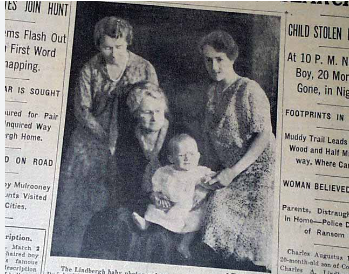Introduction: The kidnapping of Charles Lindbergh Jr., the young son of famous aviator Charles Lindbergh and his wife, Anne Morrow Lindbergh, remains one of the most infamous and shocking crimes in American history. The crime, which took place in 1932, captivated the nation, led to a massive investigation, and ultimately resulted in one of the most controversial trials of the 20th century.
The Facts of the Case: On the night of March 1, 1932, Charles Lindbergh Jr., just 20 months old, was abducted from his nursery in the family’s home in Hopewell, New Jersey. The abduction was discovered when the nurse checked on the child around 10 PM and found that he was missing. A ransom note, demanding $50,000 for the child’s return, was found at the scene. The Lindberghs, who were well-known public figures, immediately contacted the authorities, and the search for the child began.
Over the next several weeks, multiple ransom notes were delivered, and the family, under the advice of authorities, agreed to pay the demanded ransom. However, despite the payment, Charles Lindbergh Jr. was never returned, and the case took a tragic turn when his body was found on May 12, 1932, less than five miles from the Lindbergh home. The child had been dead for some time, and the cause of death was determined to be a blow to the head.
Key Figures Involved:
- Charles Lindbergh: The famous aviator who became a national hero for his historic solo flight across the Atlantic in 1927. The kidnapping of his son devastated him and his wife, but it also turned the Lindberghs into the focal point of the crime.
- Anne Morrow Lindbergh: Charles Lindbergh’s wife and mother of the kidnapped child. She was an accomplished author and aviator in her own right. The kidnapping brought immense media scrutiny to her family.
- Bruno Richard Hauptmann: A German immigrant and carpenter, Hauptmann was arrested in 1934 after a yearlong investigation. He was accused of being the mastermind behind the kidnapping and the murder of the Lindbergh child. The evidence against Hauptmann, including a ransom bill found in his possession, led to his conviction in 1935. Hauptmann was sentenced to death and executed by electrocution in 1936.
Theories and Conspiracies: The Lindbergh kidnapping case quickly attracted widespread media attention, and numerous theories and conspiracies arose, some questioning Hauptmann’s guilt and others suggesting there was more to the story than met the eye.
- Hauptmann’s Guilt: The prosecution argued that Bruno Hauptmann was responsible for the kidnapping and murder of Charles Lindbergh Jr. He was found with a portion of the ransom money, and handwriting analysis supposedly linked him to the ransom notes. However, many believed the evidence was circumstantial, and doubts about Hauptmann’s role persist to this day. Some theorists suggested that Hauptmann might have been framed, or that others were involved in the crime.
- The “Insider” Theory: Some conspiracy theorists argue that the kidnapping could have been an inside job. They suggest that someone close to the Lindbergh family—perhaps even someone in their household—might have been involved in orchestrating the abduction. This theory is based on the suggestion that the kidnapper had knowledge of the family’s routine and the layout of the house.
- The “German Plot” Theory: Given Hauptmann’s German background, some conspiracy theories suggested that the kidnapping was connected to political motives, perhaps involving the rise of Nazi sympathizers in the U.S. at the time. However, no solid evidence has ever been found to support this theory.
- Lindbergh’s Own Involvement: A more fringe theory claims that Charles Lindbergh might have had some involvement in the crime, possibly in an attempt to stage an abduction for financial gain or even to escape the pressures of fame. This theory has little support but has nonetheless been explored by some.
Quotes:
- Dr. John F. Condon, a mediator during the ransom negotiations: “I don’t want to see anyone hurt, I want the boy back.”
- Bruno Hauptmann, in his last words before execution: “I am innocent. I have not committed this crime. I didn’t kill that child.”
Verdict and Current Status: Bruno Hauptmann’s conviction remains one of the most controversial in American legal history. Despite the evidence against him, many believe he was wrongfully convicted. The case, however, was considered a closed chapter with Hauptmann’s execution in 1936, and there have been no conclusive breakthroughs in the decades since.
In 1971, a book titled The Lindbergh Kidnapping Case by crime writer Henry J. Stimson reignited interest in the case, suggesting that Hauptmann might have been innocent and that the true culprit had never been identified. Various groups and individuals have continued to push for a re-examination of the case over the years, but no new evidence has led to a posthumous exoneration.
Conclusion: The Lindbergh kidnapping case remains one of the most well-known and controversial crimes in U.S. history. Despite a conviction and execution, the questions surrounding Hauptmann’s guilt and the circumstances of the crime persist. For many, the case symbolizes the intersection of fame, crime, and the relentless pursuit of justice.


























